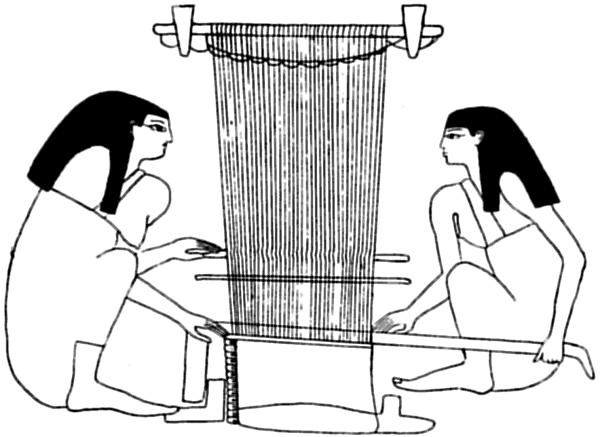Transcriber's Note
There is a small amount of Greek in this text, which may require adjustmentof your browser settings to display correctly. A transliteration ofeach word is included. Hover your mouse over words underlined with afaint red dotted line to seethem.
Text underlined with a faint grey dotted linehas been amended; a list is also provided at the end of the text.
Ancient Egyptian and
Greek Looms
BY
H. LING ROTH
(Keeper).
WITH 38 LINE BLOCK AND ONE COLLOTYPE ILLUSTRATIONS.
BANKFIELD MUSEUM, HALIFAX
APRIL 1913
CONTENTS
Preface.
I. Egyptian Looms.
II. The Greek Loom.
III. Conclusion.
PREFACE.
Halifax, which is situated in the heart of the great textile tradeof Lancashire and Yorkshire, has been a home of the woollen manufacturesince the earliest time, and it is only meet, therefore, that itsmuseum should possess specimens of the tools used in the early daysof spinning, weaving, and cloth making generally. In spite of theconsiderable progress made towards that end, many typical specimensare still wanting, and, while we have plenty of material for thestudy of weaving in various parts of the world, we are lacking ineverything relating to the industry in Ancient Egypt and Greece.Failing specimens I have had recourse to illustrations, but theEgyptian ones published by Cailliaud, Rosellini, Sir J. G. Wilkinsonand Lepsius, contradict each other in many important points, so thatthose who study them find them practically useless for an understandingof the art as carried on in the Nile lands. Fortunately, lastyear, Mr. N. de G. Davies, the well-known Egyptologist, hearing ofmy difficulty, very generously placed some of his copies of tombdrawings at my disposal, and with this invaluable help I have beenenabled to complete the present paper, and to lay before Halifaxstudents some new details of manufacture bearing upon their stapleindustry.
H. Ling Roth.
Bankfield Museum, Halifax.
April 1913.
I. Egyptian Looms.
HORIZONTAL LOOMS.[A]
IN the tomb of Chnem-hotep, at Beni Hasan, there is a wall paintingof a horizontal loom with two weavers, women, squatting oneither side, and at the right in the background is drawn the figure ofthe taskmaster. There are also figures represented in the act ofspinning, etc. For the present we are concerned with the weavingonly.
Fig. 1.—Horizontal Loom, Tomb of Chnem-hotep, from the illustration in Cailliaud’sRecherches, etc. Same size as published.
Of this illustration, there appear to be six reproductions. Wehave first of all, Fig. 1, that of Fred. Cailliaud (Recherches sur lesArts et Métiers, etc., Pa
